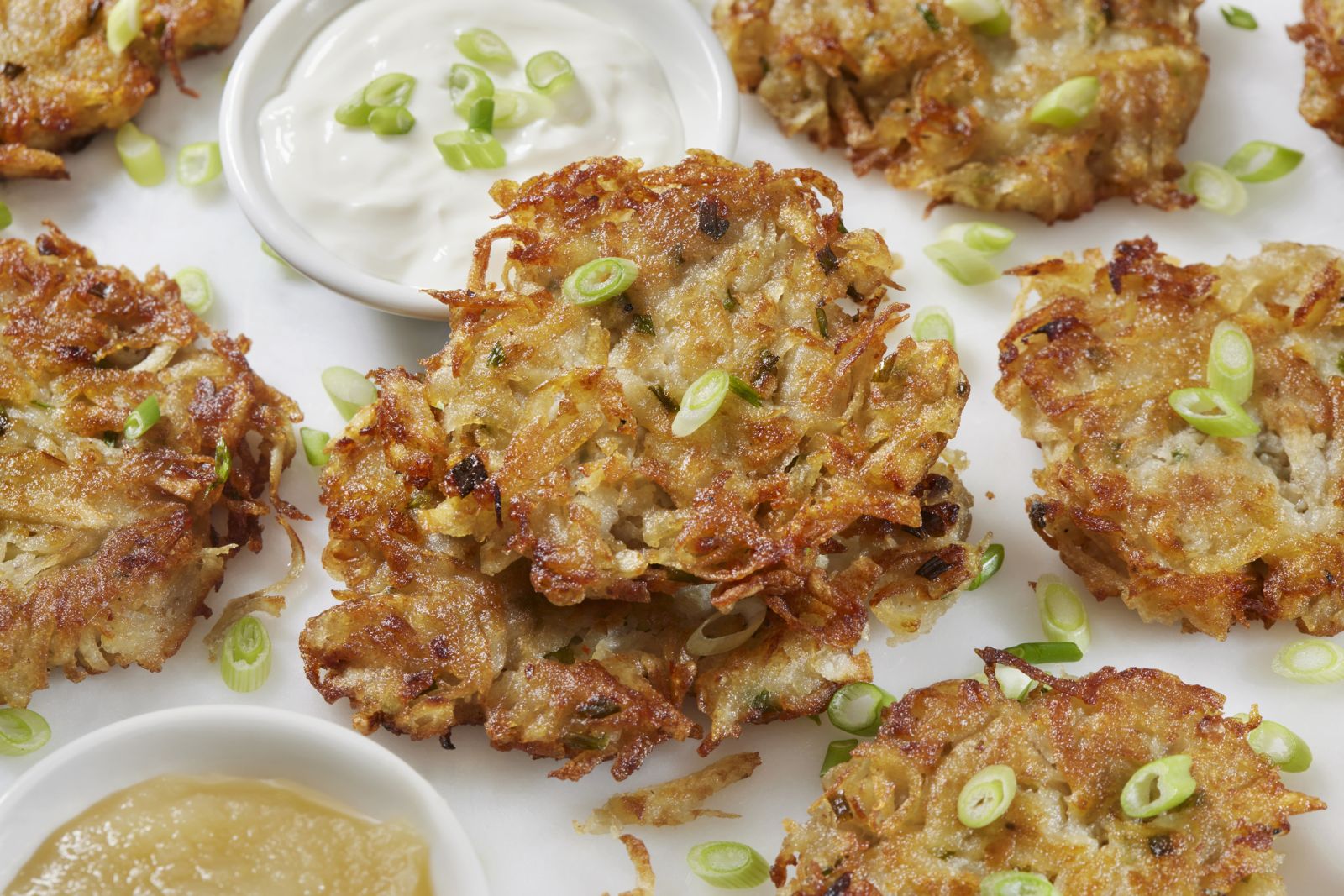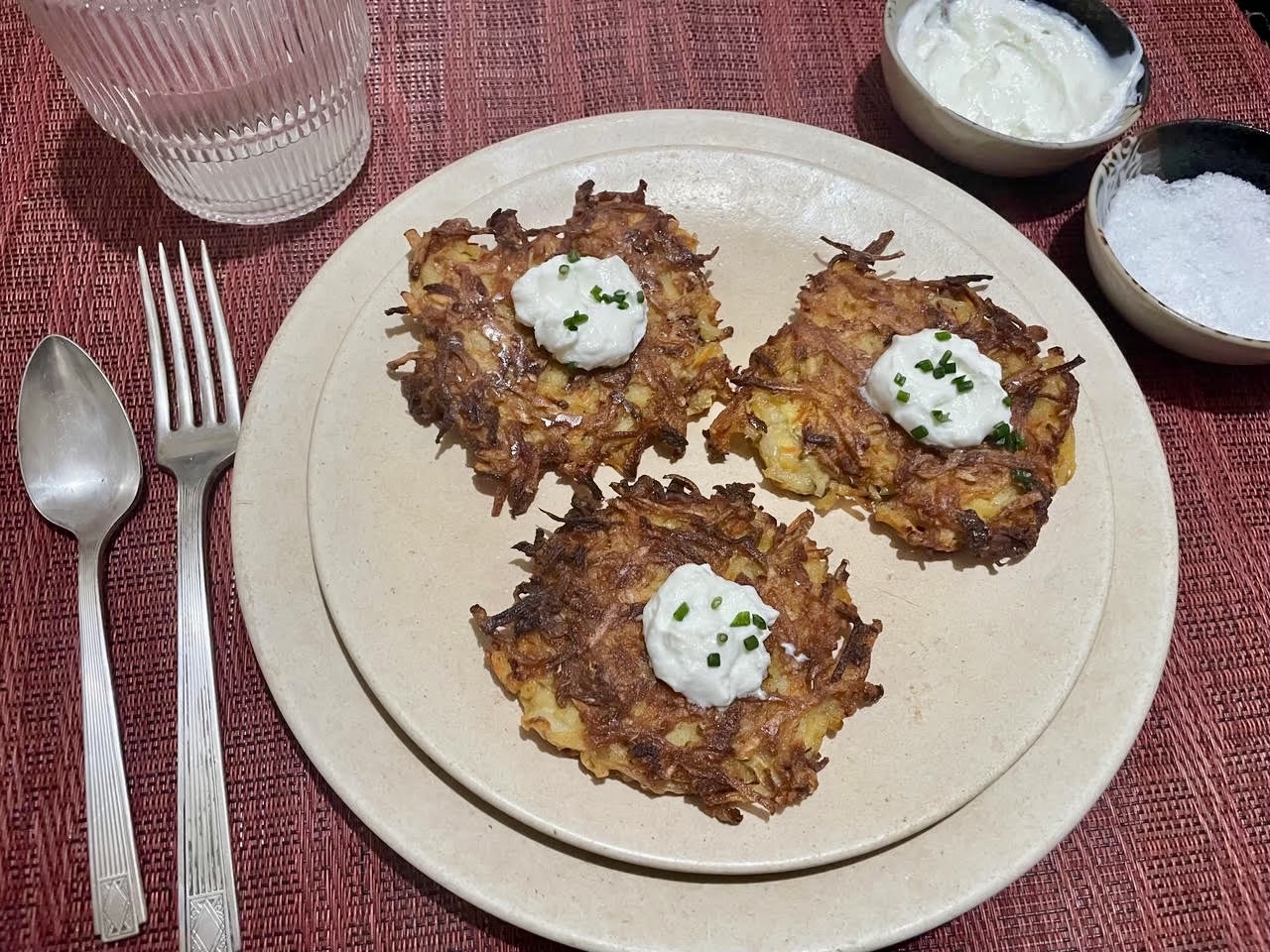Root Vegetable Latkes: A Healthier Recipe for a Hanukkah Favorite
By Amy Sherman
 A tradition of Hanukkah, latkes are typically made with potatoes and white flour, then fried. A few tweaks make this version lower in carbs and higher in nutrients.
A tradition of Hanukkah, latkes are typically made with potatoes and white flour, then fried. A few tweaks make this version lower in carbs and higher in nutrients.
Like Christmas, Hanukkah is a holiday with presents, special family meals, and special activities and treats for kids. As a child, Hanukkah felt like our version of Christmas. And like so many Jewish holidays, it's also a celebration of the survival of the Jewish people. As an adult I skip the gifts but still light a menorah, the traditional Hanukkah candelabra, and savor potato latkes topped with sour cream and applesauce.
What is Hanukkah?
Hanukkah, also known as the Festival of Lights, is a Jewish holiday commemorating the rededication of the temple in Jerusalem in 164 B.C. It is celebrated for 8 days and while most menorahs are lit nightly with candles, eating foods fried in oil is symbolic of the miracle of oil lasting 8 days in the temple's eternal lamp after a military victory of the Maccabees. In Israel, Jews eat doughnuts called sufganiyot, but in the US, Jews eat potato pancakes called latkes.
What are latkes?
Made from potatoes, eggs, and flour, latkes are potato pancakes traditionally made with grated potatoes that are fried in oil until crisp. A delicious comfort food with Eastern European roots, latkes are a prime candidate for a healthy diabetes-friendly makeover.
How to make latkes healthier
Registered dietitian and trained chef Jackie Newgent, who is author of “The Plant-Based Diabetes Cookbook,” explains why the classic latkes recipe could use an update for anyone managing blood sugar levels. “Since latkes are traditionally based on potatoes (a starchy vegetable) and white flour, they have a significant amount of carbs. People with diabetes need to manage their total carbohydrate intake – and may need to stick to only a petite portion of latkes or perhaps skip them altogether if they’re paired with a carb-rich meal.”
Fortunately, a little tweaking not only makes latkes healthier but also more delicious. The biggest change to the latkes is to swap out some of the potatoes for vegetables.
“For a diabetes-friendlier nutrition profile, you can swap half of the russet potato with carrot. Ounce per ounce, carrots have significantly fewer carbs and more dietary fiber than potatoes – plus bonus color and antioxidants thanks in part to beta carotene. Carrots are root veggies that are non-starchy and count as a low glycemic food. Of course, when using potatoes, keep the skin on to keep all its nutrition, including fiber.”
 We've not only added carrots to our recipe but also parsnips, which have significantly more dietary fiber than potatoes and add a nutty flavor.
We've not only added carrots to our recipe but also parsnips, which have significantly more dietary fiber than potatoes and add a nutty flavor.
Another health tip from Newgent is to use a bit less salt in the latke mixture and focus on finishing with a bit of salt instead:"Don't skip the salt used for sprinkling on top,” she said. “It can seem saltier to your eyes and your taste buds this way, even when using less overall salt.”
Another tip from Newgent is to use an equal amount of whole-wheat pastry flour instead of all-purpose flour for whole-grain benefits. Unlike standard whole-wheat flour, which has more texture than all-purpose flour, whole wheat pastry flour is made from soft spring wheat and is more finely ground than standard whole-wheat flour. It also has less protein, making it a better substitute for all-purpose flour.
Cooking Latkes
While using oil in a latkes recipe is inescapable, baking them with oil rather than frying them is not only less messy but yields surprisingly crispy and delicious latkes. That’s the only major technique change and the final tweak to the classic recipe. Latkes are terrific for breakfast, lunch or dinner, but also as a side dish. I hope you'll enjoy the recipe, whether you are celebrating Hanukkah or just looking for a festive dish to serve your family or friends.
Recipe Details: Carrot, Parsnip, and Potato Latkes
Active time: 15 minutes
Total time: 45 minutes
Makes: 4 servings (12 latkes)
Total carbohydrates: 31 grams per serving
Ingredients
-
1 large russet potato
-
2 carrots
-
2 parsnips
-
1 onion, peeled, trimmed, and cut into quarters
-
2 large eggs
-
1/4 cup whole-wheat pastry flour
-
1 teaspoon kosher salt, divided, plus more for sprinkling
-
1/2 cup extra-virgin olive oil or other oil for frying
-
Toppings such as Greek yogurt, applesauce, and chopped chives or scallions
Instructions
-
Heat the oven to 425°F and pour 1/2 cup of oil on a rimmed sheet pan, preferably a non-stick pan. Place the oiled sheet pan in the oven and heat for 10 minutes.
-
Wash but do not peel the vegetables and trim the top of the carrots and parsnips. Using a box grater or food processor with a coarse grating disc, grate the potato, carrots, parsnips, and onion. Transfer the mixture to a large mixing bowl, sprinkle with 1/2 teaspoon of salt, stir, and let sit for 10 minutes. Scoop the mixture out of the bowl and into a clean dish towel. Use the towel to squeeze out as much liquid as possible.
-
Transfer the grated vegetables back to the mixing bowl. Add the eggs, flour, and remaining salt and mix until the flour is absorbed.
-
Carefully remove the sheet pan from the oven. Scoop 1/4 cup mounds of the latke batter into your hand, then very firmly flatten and place on the pan. Use a spatula to flatten each latke and bake for 20 to 25 minutes, until deep golden brown on the bottom and edges.
-
Remove the pan from the oven and flip the latkes using a spatula, pressing them down into the oiled pan, then bake for an additional 10 to 15 minutes, until brown on both sides.
-
Transfer the latkes to a paper towel-lined plate, blot with paper towels to remove excess oil, and sprinkle with salt. Top as desired and serve while still warm.
Photo credits: iStock (top); Amy Sherman (bottom).








